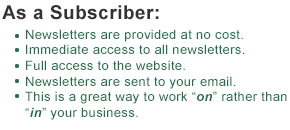It's Never too Early to Start Planning Your Business Exit
In the last issue (#43), we discussed The Right Time to Sell Your Business. In this issue we will emphasize It's Never too Early to Start Planning Your Business Exit.
A Favorite Famous Quote
"You see, in life, lots of people know what to do, but few
people actually do what they know. Knowing is not
enough! You must take action." Anthony Robbins
It's Never too Early to Start Planning Your Business Exit
The ROCG business transition survey, which we cited in Issue #3 - Amazingly Poor Business Exit Planning Statistics, indicates the number one reason owners provide for not having a business transition/succession plan is it was "too early." That is not an acceptable excuse because it is never too early to start planning your business exit.
 |
Because it will likely lead to increased profitability, it's never too early to start planning your business exit.
|
Conquering obstacles to a sale requires time
In Issue #23 - 66 Obstacles to a Successful Business Sale, we identify a comprehensive list of impediments that might be encountered. If not addressed, each of those obstacles can potentially squelch your ability to close on the sale of your business. Many of the obstacles require time to properly address them. Most professional advisors recommend at least a 3 to 5 year exit planning time frame because it can take that long to overcome some obstacles.
Second-level management
For instance, one major obstacle is lack of second-level management. It is almost imperative to have a key person who is capable of running the business in your absence. If you don't have that currently, it's not going to happen overnight. That obstacle can easily require several years to properly address it. For more information, read: Issue #67 - Inadequate Second-Level Management.
C-Corporation Tax Implications
As another example, here is an obstacle that can require 10 years to overcome. Owners whose companies are organized as a C-Corporation face very significant and detrimental tax implications when the business is sold. As the tax regulations are currently written, to garner the tax benefits of S-Corporation status upon an asset sale of the business, the entity has to be an S-Corporation for 10 years. That's a significant time period and it's an obstacle that is frequently encountered. For more information, read: Issue #64 - C-Corporation Tax Implications.
Three years . . . 10 years, but does that adequately make the argument that it's never too early to start planning? Never can be a long time, so, no it doesn't really adequately make the argument. But the following paragraphs do.


Overcoming obstacles can also increase profitability
Identifying and overcoming obstacles not only helps make your business saleable, it will also lead to increased profitability. After you identify and conquer common obstacles like Issue #57 - Inadequate Seller's Discretionary Earnings, Issue #58 - Low or Inconsistent Gross Margins and Issue #59 - Inadequate Marketing and Sales Efforts, your will bottom-line earnings will improve. Developing second-level management can free you up to concentrate on growing the business. Diversifying your customer base to overcome concentration issues may also result in more revenues. Understanding and tracking the unique metrics of your business can help you identify growth opportunities. Understanding buyers' risks and motivations may force you to address issues that might otherwise linger. The list could go on and on. Almost every obstacle you identify and address can have a positive effect on your profitability.
Example - with a business exit plan, Tom is $2,700,000 richer at age 60
To better illustrate the benefit of an early start, let's put numbers to an early start vs. a late start in business exit planning using Tom as the business owner. In scenario #1, at age 35, Tom acquires a business with $200,000 of seller's discretionary earnings (SDE) for $600,000. Let's assume he runs the business until age 60 and consistently generates the same $200,000 in SDE for the full 25 years. Over that time frame, with no exit planning, his 25-year cumulative SDE is $5,000,000 and he's able to sell the business for the same $600,000. Cumulative SDE plus sales price equals $5,600,000 (25 years x $200K + $600K).
In scenario #2, let's assume Tom begins to plan for his exit at age 55 (five years before he sells) and successfully implements changes to overcome obstacles over a two-year period and raises his SDE for the last three years (before he sells at age 60) to $300,000. With the $300,000 SDE, his business is now sold for $900,000. Cumulative SDE plus sales price equals $6,200,000 (22 years x $200K + 3 years x $300K + $900K).
In scenario #3, let's assume ...
![]()
![]()



